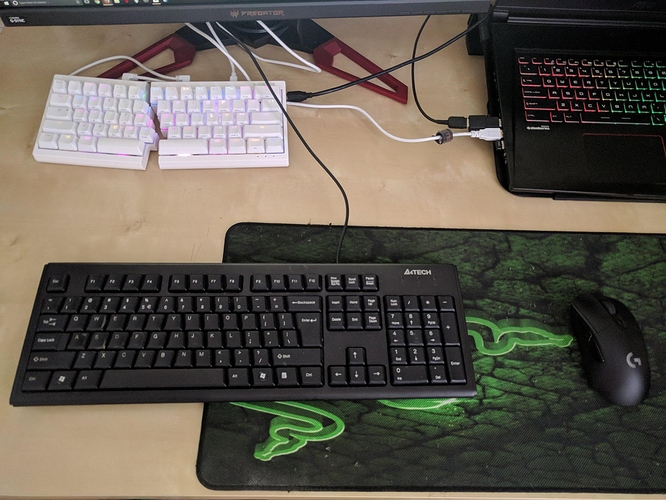Hi All,
I’d like to propose and mock up a Gaming layer for the Model 01.
Edit: included layout in original post.

The current problem with the default QWERTY layout for gaming lies with the shape of the Model 01. This was covered in the previous discussion around WASD/ESDF. WASD vs ESDF for mouse movement keys
Gaming on a regular keyboard requires one to shift their hand one column to the left in order to utilise WASD as the new home position and access Shift, Ctrl, Tab with your pinky as modifiers. Doing this on the Model 01 will completely negate the point of using an ergonomic keyboard.
In that thread there were several observations made that identified a use for a gaming layer based off QWERTY that could be switched to whilst gaming. I see two advantages to this:
- Those who come from a different typing layout such as Dvorak, Colemak or Workman wouldn’t have to remap keys at the beginning of every game, they can just switch to this QWERTY based layout that will work with default key configurations that comes with the game.
- This layer could account for the ergonomic shape of the Model 01 and put frequently used keys and modifiers closer to the home row for more comfort, reducing the need to awkwardly position the left hand in a place that negates the ergonomic curve.
The first suggestion I would make is moving the letter keys over one column to the right, so that WASD lines up with ESDF on the default QWERTY layout. This would maintain ergonomic comfort for the majority of people who use index, middle and ring fingers for movement in games as it preserves the intended home row position. This was the main discussion in the aforementioned thread.
I would then suggest moving Tab, Shift and Ctrl next to Q, A and Z respectively (Tab = R1C1, Shift R2C1, Ctrl = R3C1). Some games require chording and a frequent use case is holding Shift to sprint whilst using WASD to move and pressing Space to jump. If Shift stays on the thumb keys then chording Shift and Space would be difficult.
Thirdly, Space would have to be located on the left Thumb arc in order to be access by the left hand. The right hand will in most use cases be on the mouse so commonly used keys will have to be rebound to the left half.
These are just some starter suggestions. I’ll start working on a visual representation of this layout soon and will post it in this thread for others to feedback on. It’ll be much easier to understand and comment on this way.
I’ll be optimizing my version of this layout with mainly first person shooters in mind, as they have the most need for quick reflexes and will benefit the most from having the corresponding default keys in convenient comfortable places for easy chording. Most other game types that I considered, be it racing games or isometric RPG’s, will also benefit from having WASD in a more ergonomic position but won’t demand much else for comforts sake due to their lack of chording.
In regards to occasionally used keys located on the right keyboard half, such as using M to mute in PUBG or pressing P to bring up the voicechat menu in Overwatch, I think a good compromise would be to keep the right half of the keyboard mapped in the default QWERTY layout and just physically locate the right half of the keyboard north the left half and using either hand to press that particular key when needed. This is currently the arrangement we’re using with our Mistel Barocco split keyboard (see below). There’s no pressing ergonomic need to remap the right half since it would be used for single key presses, unlike the left half which would permanently keep the left hand positioned over WASD.
NB: This is assuming one uses their left hand on the keyboard and right hand on the mouse.
Locating the right half of the keyboard north of the left half would also mean you could use your mouse more ergonomically in the space where the right keyboard half normally resides.
I also use lower mouse sensitivity for aiming in game so the extra mouse space makes all the difference when it comes to comfort and ergonomics.
For typing, I keep the keyboard in this position with the mouse just to the right of it.
Traditionally, this is how I used to game, with the mouse all the way to the right which can’t be great for the shoulders, especially with low sensitivity aiming requiring long movements.
I’ll start tinkering with what this should look like however as someone still waiting to receive their Model 01 I would love to get some feedback from the gamers here who already have their Model 01 with them.
Cheers all,
Jan



 .) It’s easy and fast and is absolutely not a barrier to gaming.
.) It’s easy and fast and is absolutely not a barrier to gaming.